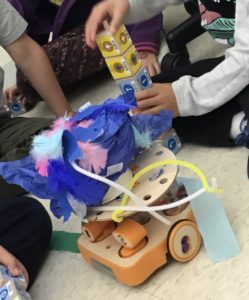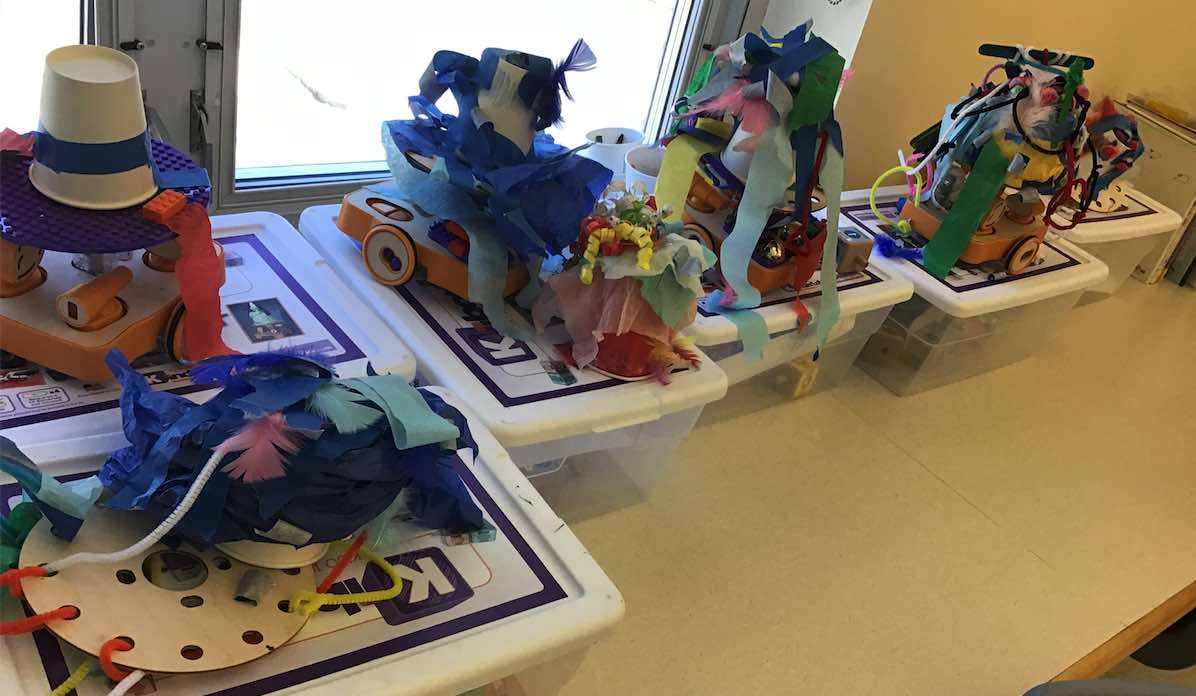After years of online or socially distanced in-person learning, students and teachers have been excited to re-engage with collaborative, fully hands-on learning. Unfortunately, some young students have never had the formative experience of sharing a learning tool. To help students learn social-emotional skills and STEAM concepts at the same time, educators can teach every one of Collaborative for Academic, Social, and Emotional Learning’s, or CASEL’s, five core principles through robotics, because SEL and robotics complement each other well.
Before a project even begins
Robotics is such a natural vehicle for social-emotional learning that, if you plan it out right, your students will practice skills in all five domains of CASEL’s framework before they even start coding. The robot that we use, KIBO, comes in ready-to-go kits — which include many different parts, such as wooden programming blocks, sensors and modules, wheels, motors and more — that allow students to grab everything they need quickly. If time is a concern, or if you want to get right to the project, this is a great way to start.
If, on the other hand, you have a bit more time to let some social-emotional learning unfold, you might want to put different pieces in different baskets, such as all the motors in one spot. By asking the students to get their own parts, teachers inspire all kinds of deliberate conversations about sharing pieces. Students need to think about their own needs to finish the project and the needs of their peers who are trying to gather the same resources. This leads them to communicate with one another, advocate for themselves, think about the consequences of these decisions for their project and communicate all this information with their peers.
This interaction involves five important SEL areas:
- Relationship skills
- Social awareness
- Self-awareness
- Self-management
- Responsible decision-making
This approach does require an investment of time, especially toward the beginning of the year or with very young students. But just as with the responsive classroom approach, it tends to pay dividends in areas like managing routines and behavior as students grow. Once you have your robots built, you can delve more deeply into the five areas above.
Self-Management

Sometimes in our classrooms, we don’t just make students gather the pieces for the screen-free robots themselves; we also give them fewer robots than they will collectively need, because it can force them to share, take turns or perform assigned roles in coding projects.
We know it’s hard to share and wait, so early in the year we assign roles to students, such as naming one the coder, another the builder and so on. As the year progresses, those roles begin to become part of their vocabulary, and they work together to assign their own roles or even trade them back and forth.
The dream is to hear students across the room saying things like, “You go first, and then I’ll get a turn.” With younger students, we often have to settle with progress toward that goal in lieu of actually achieving it. The important part is that they are practicing self-management while they wait, not that they are already perfect at it.
Responsible decision-making
Students have to make a lot of decisions during a coding project. To help bring them to the front of mind, a reflection period at the end of the project can be helpful.
Asking students to reflect upon their experiences is just solid classroom practice no matter what students are learning or what tools they are using. But when we ask younger students to reflect on robotics experiences, those reflections tend to be about the social-emotional learning in the project in addition to questions about coding.
Questions such as “What went well today?” “What challenges did you face, and how did you overcome them?” “What strategies did you use?” can help students think about the decisions they made and the consequences that flowed from them.
Taking care of the robots is also an opportunity for students to practice responsible decision-making. Working with robots is a favorite activity for so many students. When we stress that the robots need to be treated well so that they will continue to be available for students to use, they tend to take that responsibility very seriously and work to clean everything up and put their materials away properly.
Relationship skills
Group coding projects are full of opportunities to practice relationship skills. For example, Barbara’s classes have often done a project built around a windy day. The idea is to incorporate science vocabulary as students build and decorate a robot that moves in a way that evokes the wind.
To foster relationship skills, we intentionally assign three to four students to work with one robot, sometimes with roles such as programmer, constructor or materials gatherer. They use a planning sheet to guide the discussion about the robot parts and art materials they want to use, and they have to come to a consensus about what their robot will look like and how it will move. Another way this collaboration can work is if each student creates their own decoration, which they can take a turn placing on the robot and then take home after the project is over.
It really is the culmination of so many different kinds of relationships coming together for a larger, more exciting purpose.
Social awareness
SEL and robotics activities also dovetail as students who don’t typically shine in an academic setting are allowed to truly stand out. Sometimes it actually surprises their classmates just how capable they are. It’s usually the kid who is a little bit more oriented toward engineering. They will understand how the motor is going to work, for example, and what effect that’s going to have, and then their peers will actually listen to their explanation.
As a teacher, it’s so fun and gratifying to see students noticing a peer who generally flies under the radar shining, and then lift them up.
Self-awareness
Self-awareness is another domain of social-emotional learning that is just inherently woven through group coding projects. People simply can’t work in groups effectively without practicing some level of self-awareness, so it’s something we’re always working on when students code.
One concept that we’ve used to make it more explicit is the repeat loop, which is one of the commands that students can use to program the robot. When we work with this, we ask students about things that happen every year to get them to practice the self-awareness skill of integrating personal and social identities and identifying their personal cultural and linguistic assets.
If we’re working on it before winter break, they might talk about sledding or a Christmas tree or a menorah, but they each bring in something their families do every year that reflects who they are and what’s important to them. Then they add some physical representation of that to their robots.
Putting SEL and robotics all together
There are also strategies we implement in our units that cover multiple SEL competencies. In early lessons, we often focus on teaching the skills explicitly before teaching the programming concepts or specific coding blocks.
For example, in a lesson on handling difficult emotions, we introduce the lesson by talking about strategies students can use when they feel frustrated. We help them understand what the word means and when they might experience that feeling during a robotics activity, such as when waiting for a turn or when the robot doesn’t do what they want it to do. We identify and practice different strategies, such as breathing exercises or raising a hand and simply saying, “I’m feeling frustrated.”
At the end of such a lesson, we reflect as a group and discuss when students experienced these emotions and which strategies we used in the moment. Once we’ve completed this lesson and we move on to more complex coding concepts, we often refer back to this lesson, encouraging our students to continue using these strategies in future lessons. They can practice these strategies in other subject areas as well, reinforcing their skills throughout their day and for the remainder of their year.
Being able to identify the emotions experienced during robotics builds self-awareness. Being able to express them and apply new strategies builds self-management and responsible decision-making. And reflecting on our emotions and strategies as a group can help develop social awareness and relationship skills.
The truth is, you just can’t teach robotics unless you start with SEL. It would result in total chaos and a lot of tears. Using this SEL-embedded approach doesn’t just avoid the tears, it allows students to learn collaboration and coding concurrently.
Megan Bounit is the director of educational technology for Wellesley Public Schools. She can be reached via email.
Barbara Tennyson is an instructional technology specialist at Needham Public Schools, where they use the KIBO robot in kindergarten and first-grade tech classes. She can be reached via email.
Opinions expressed by SmartBrief contributors are their own.
_________________________
Subscribe to SmartBrief’s FREE email newsletter to see the latest hot topics on EdTech. It’s among SmartBrief’s more than 250 industry-focused newsletters.
